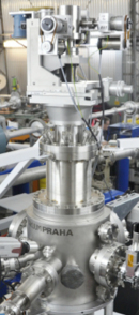Nuclear Microprobe and Detector Testing (NMICRO)
Ruđer Bošković Institute in Zagreb
Currently the Nuclear Microprobe and Detector Testing (NMICRO) is offered with the following restrictions: only ions provided by 1 MV TDT accelerator.
Nuclear microprobe is a device that uses a system of quadrupole lenses (depending on the application it could be doublet, triplet or quintuplet) to focus an ion beam to the micrometer size. Focused ion beam is scanned over the sample surface (typically up to 1×1 mm2). The available beams are protons (0.4 to 8 MeV) and most of other heavier ions up to ME/q2 ratio of 15 MeV. Typical currents used for most of the ion beam analysis (IBA) techniques, such as PIXE and RBS, are between 1 and 1000 pA. The beam spot size depends on ion species being focused, their energy and current.
In the high current operation mode case needed for the ion beam analysis, PIXE and/or RBS is operated by proton or He ion beam. For the ion beam analysis and of light isotopes, a nuclear reaction analysis (NRA) is being used; often this is done by He3 ion microbeam. Typical spot sizes in the high current mode can be as low as 1 m.
In the low current operation mode of the nuclear microprobe (ion beam currents < fA) techniques such as STIM (scanning transmission ion microscopy) and IBIC (ion beam induced charge) are used. IBIC technique is used for imaging of transport properties in radiation detectors and other electronic devices. Ion microbeam can in that case be used for in situ study of materials radiation hardness or creation of single event upsets in electronic circuits. For the most favourable conditions the beam spot size of the low current mode can be as low as 250 nm.

Contact: Zdravko Siketic
Technical specifications
More detailed information can be found on the instrument’s webpage.
-
20.02.2025
X-ray computed tomography (CT) TomoLab
-
23.01.2025
THz beamline TeraFERMI



